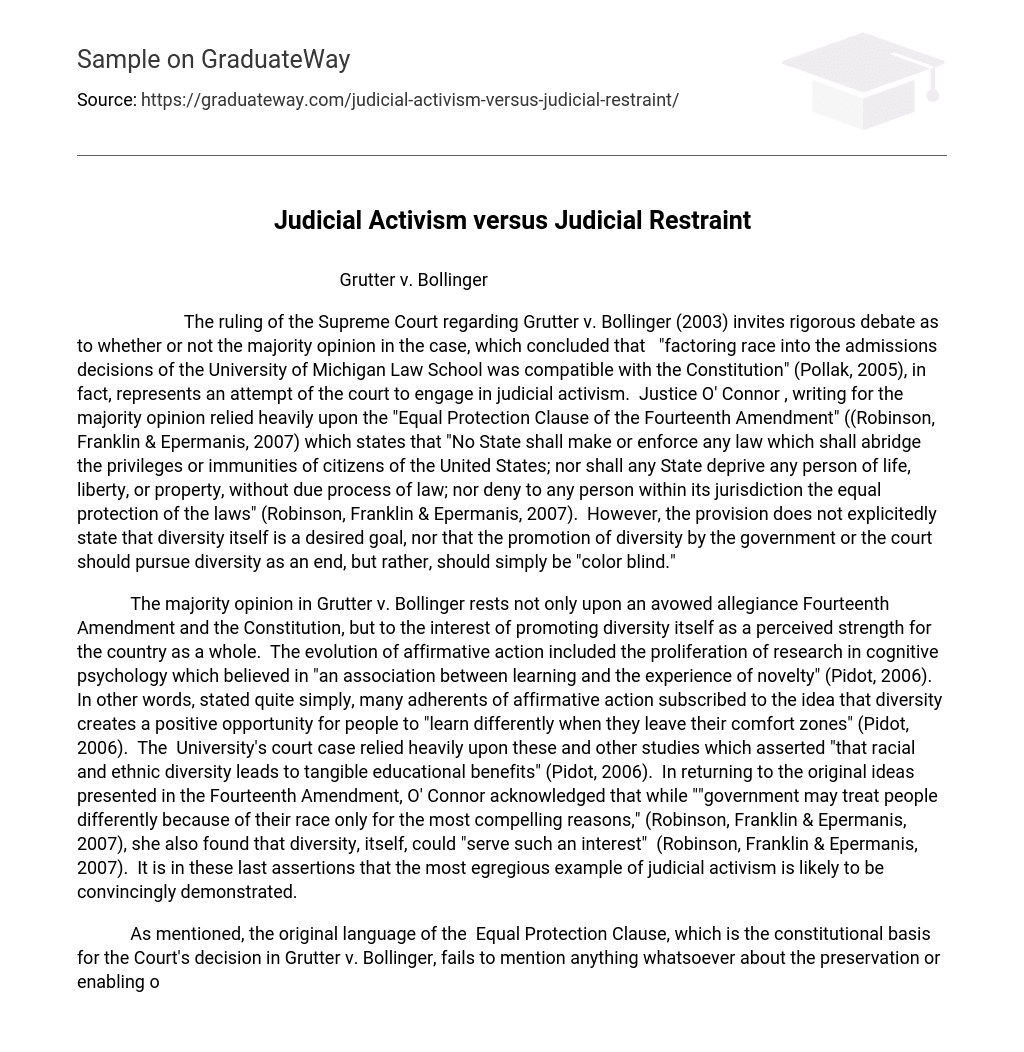Grutter v. Bollinger
The ruling of the Supreme Court regarding Grutter v. Bollinger (2003) invites rigorous debate as to whether or not the majority opinion in the case, which concluded that “factoring race into the admissions decisions of the University of Michigan Law School was compatible with the Constitution” (Pollak, 2005), in fact, represents an attempt of the court to engage in judicial activism. Justice O’ Connor , writing for the majority opinion relied heavily upon the “Equal Protection Clause of the Fourteenth Amendment” ((Robinson, Franklin & Epermanis, 2007) which states that “No State shall make or enforce any law which shall abridge the privileges or immunities of citizens of the United States; nor shall any State deprive any person of life, liberty, or property, without due process of law; nor deny to any person within its jurisdiction the equal protection of the laws” (Robinson, Franklin & Epermanis, 2007). However, the provision does not explicitedly state that diversity itself is a desired goal, nor that the promotion of diversity by the government or the court should pursue diversity as an end, but rather, should simply be “color blind.”
The majority opinion in Grutter v. Bollinger rests not only upon an avowed allegiance Fourteenth Amendment and the Constitution, but to the interest of promoting diversity itself as a perceived strength for the country as a whole. The evolution of affirmative action included the proliferation of research in cognitive psychology which believed in “an association between learning and the experience of novelty” (Pidot, 2006). In other words, stated quite simply, many adherents of affirmative action subscribed to the idea that diversity creates a positive opportunity for people to “learn differently when they leave their comfort zones” (Pidot, 2006). The University’s court case relied heavily upon these and other studies which asserted “that racial and ethnic diversity leads to tangible educational benefits” (Pidot, 2006). In returning to the original ideas presented in the Fourteenth Amendment, O’ Connor acknowledged that while “”government may treat people differently because of their race only for the most compelling reasons,” (Robinson, Franklin & Epermanis, 2007), she also found that diversity, itself, could “serve such an interest” (Robinson, Franklin & Epermanis, 2007). It is in these last assertions that the most egregious example of judicial activism is likely to be convincingly demonstrated.
As mentioned, the original language of the Equal Protection Clause, which is the constitutional basis for the Court’s decision in Grutter v. Bollinger, fails to mention anything whatsoever about the preservation or enabling of diversity and, instead, seems to suggest that the elimination of prejudice and discrimination are the only goals set forth under the provision itself.
Because the concept of judicial restraint is that judges should limit their personal power in order to more accurately uphold the legislative and constitutional precedents which serve to shape the laws of the American democracy, the issue of diversity as a valued end in itself seems to be an example of judicial activism.
Of course, the protection of minority rights is desirable in a democracy, the original impetus behind affirmative action targeted a limited and time-specific set of strategies to redress an historical imbalance in social-poltical justice which was based on ethnicity and race. The idea that “diversity has become a legitimate organizational goal in and of itself–one which is sufficient to serve a compelling government interest” (Robinson, Franklin & Epermanis, 2007) is a concept which cannot be demonstrated to have been derived from the Constitution or the existing affirmative action statues which occasioned the Grutter v. Bollinger case. Under the Supreme Court’s ruling, the existing idea that affirmative action redress was to be of limited duration may have been skewed. In effect, the “decision may have also eroded the requirement previously mandated under narrowly tailored that affirmative action programs must be temporary in duration” and this is, in itself, an extension of a legislative function more properly addressed, not by the court, but by the legislative branches of government. The decision by the Supreme Court in the case of Grutter v. Bollinger demonstrates a judiciary body activist force.
References
Pidot, J. (2006). Intuition or Proof: The Social Science Justification for the Diversity Rationale in
Grutter V. Bollinger and Gratz V. Bollinger. Stanford Law Review, 59(3), 761+.
Pollak, L. H. (2005). Race, Law & History: The Supreme Court from “Dred Scott” to “Grutter V.
Bollinger”. Daedalus, 134(1), 29+.
Robinson, R. K., Franklin, G. M., & Epermanis, K. (2007). The Supreme Court Rulings in
Grutter V. Bollinger and Gratz V. Bollinger: The Brave New World of Affirmative
Action in the 21st Century. Public Personnel Management, 36(1), 33+.





